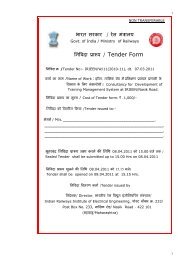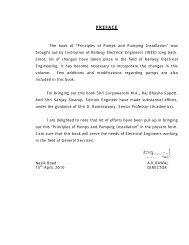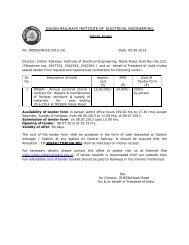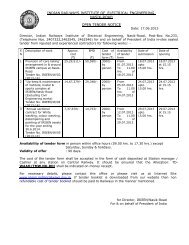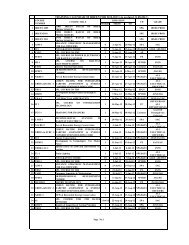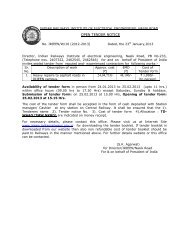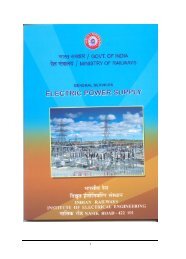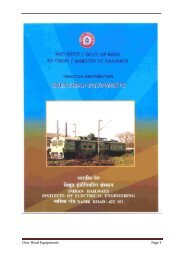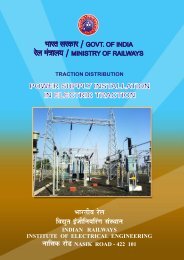Traction Rolling Stock - Indian Railways Institute of Electrical ...
Traction Rolling Stock - Indian Railways Institute of Electrical ...
Traction Rolling Stock - Indian Railways Institute of Electrical ...
Create successful ePaper yourself
Turn your PDF publications into a flip-book with our unique Google optimized e-Paper software.
train. Failure <strong>of</strong> the orange lamps to light up when brakes are applied indicates partial failure <strong>of</strong> the<br />
EP brakes. The Driver has to be very vigilant and should be prepared to control the train, if<br />
required, by using auto brakes.<br />
7.3.7 Automatic brakes<br />
Fig. 7.3.7 is a block diagram explaining the function <strong>of</strong> the automatic brakes. When the<br />
brake controller in the driving cab is in position I and the controller is put into operation by putting<br />
on the ‘isolating valve switch' compressed air is fed to the brake pipe from the MR pipe via a<br />
reducing valve in the brake controller which ensures that the pressure in the brake pipe is built up<br />
and remains steady at 4.57 kg/cm².<br />
The vital component in the automatic brake system is the triple valve which<br />
forms a part <strong>of</strong> the EP brake unit in each coach, its functions are -<br />
7.3.7.1 When pressure in the brake pipe is 4.57 kg/cm², it opens the brake cylinder to atmosphere<br />
thus releasing the brakes and at the same time connects the brake pipe to an auxiliary reservoir in<br />
each coach storing compressed air at a pressure <strong>of</strong> 4.57 kg/cm² in the auxiliary reservoir.<br />
7.3.7.2 When pressure in the brake pipe is reduced either voluntarily by the Driver or the Guard or<br />
due to parting <strong>of</strong> train or operation <strong>of</strong> the dead-man's device etc., it closes the exhaust from the<br />
brake cylinder and connects the auxiliary reservoir to the brake cylinders, allowing the stored air in<br />
the reservoir to flow into the brake cylinders. The volume <strong>of</strong> the auxiliary reservoir is so chosen<br />
that the maximum pressure in the brake cylinders is limited to 3.5 kg/cm². The triple valve also has<br />
a lap position whereby it is possible to control the brake cylinder pressure to values below 3.5<br />
kg/cm² by holding the brake pipe pressure at intermediate values making use <strong>of</strong> position III on the<br />
brake controller.<br />
7.3.7.3 When the brake pipe is recharged by moving the controller to position I, the triple valve<br />
returns to the position indicated in (a) thus releasing the brakes and storing air in the auxiliary<br />
reservoir in readiness for the next application.<br />
A triple valve stabilizing valve is provided in the circuit which ensures that the triple valve does not<br />
react to small pressure pulsation.<br />
7.3.8 Emergency brakes<br />
In position V (i.e. emergency) <strong>of</strong> the brake controller, both EP and auto brakes apply together.<br />
Rapid application <strong>of</strong> the automatic brakes is obtained by quick venting <strong>of</strong> the brake pipe to<br />
atmosphere. A safety valve in the brake unit on each coach prevents excessive pressure in the<br />
brake cylinders. This valve is normally set at 3.9 kg/cm².<br />
Release <strong>of</strong> the dead-man's device by the Driver result in quick venting <strong>of</strong> the brake pipe<br />
to atmosphere via an emergency valve resulting in full auto application.<br />
7.3.9 Description <strong>of</strong> other equipments<br />
A valve is provided in each driving cab to enable the Guard to vent the brake pipe to<br />
atmosphere and thus cause brake application. A gauge is provided close to this valve to indicate<br />
the brake pipe pressure to the Guard.<br />
A pressure switch usually called the control governor connected to the brake pipe<br />
prevents application <strong>of</strong> power to the traction motors till the brakes are kept ready. This control<br />
governor opens and cuts <strong>of</strong>f traction control supply if the brake pipe pressure is reduced.




